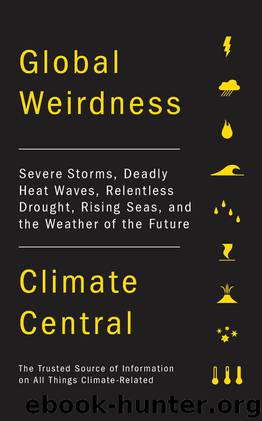Global Weirdness: Severe Storms, Deadly Heat Waves, Relentless Drought, Rising Seas and the Weather of the Future by Climate Central

Author:Climate Central [Central, Climate]
Language: eng
Format: epub
Tags: Science, Environmental Science, Nature, Environmental Conservation & Protection, Earth Sciences, Meteorology & Climatology
ISBN: 9780307743374
Publisher: Pantheon
Published: 2012-07-24T00:00:00+00:00
37
Arctic Sea Ice Has Been on a Mostly Downward Spiral for the Past Thirty Years.
Every summer above the Arctic Circle, the sun rises relatively high in the sky and stays up for as much as twenty-four hours every day. Ice on the surface of the Arctic Ocean melts back, exposing open water. But the Arctic is still cold enough, even in summer, and the ice is thick enough that it has never melted away completely, unless you go back many hundreds of thousands or even millions of years.
As global temperatures rise, however, scientists expect to see more open water each summer, on average. It has to be “on average” because wind patterns, weather systems, and water currents can have a bigger effect than global temperature in any given year. (Besides, even though global temperatures are rising steadily, they don’t change by the same amount each year.) That could mean an unusually large or unusually small amount of melting in one summer.
Over time, though, the melting should increase. That’s not just because of rising temperatures. As we’ve seen, bright white ice reflects a lot of sunlight back into space, so this “lost” energy can’t heat the surface. But when the ice melts, it exposes water, which is much darker and doesn’t reflect nearly as much light (it’s almost black). More heat stays on the surface, so air temperature goes up and causes even more melting. This feedback effect—more melting means less reflection means more heat means more melting means less reflection and so on—is called Arctic amplification, and it makes the Arctic warm up faster than the global average.
Sure enough, Arctic sea ice has melted more each summer (on average!) than the summer before since the late 1970s; and in fact, the downward trend in late-summer ice is steeper than nearly all climate models predicted. It’s possible that the trend started even earlier than that, but until about thirty years ago scientists didn’t have satellites orbiting overhead to survey the entire Arctic. They mostly had to use ships and planes, which can only make limited observations.
Download
This site does not store any files on its server. We only index and link to content provided by other sites. Please contact the content providers to delete copyright contents if any and email us, we'll remove relevant links or contents immediately.
The Lonely City by Olivia Laing(4568)
Animal Frequency by Melissa Alvarez(4148)
All Creatures Great and Small by James Herriot(3986)
Walking by Henry David Thoreau(3681)
Exit West by Mohsin Hamid(3634)
Origin Story: A Big History of Everything by David Christian(3472)
COSMOS by Carl Sagan(3346)
How to Read Water: Clues and Patterns from Puddles to the Sea (Natural Navigation) by Tristan Gooley(3239)
Hedgerow by John Wright(3106)
How to Do Nothing by Jenny Odell(3101)
The Inner Life of Animals by Peter Wohlleben(3099)
How to Read Nature by Tristan Gooley(3077)
Project Animal Farm: An Accidental Journey into the Secret World of Farming and the Truth About Our Food by Sonia Faruqi(3018)
Origin Story by David Christian(2991)
Water by Ian Miller(2950)
A Forest Journey by John Perlin(2915)
The Plant Messiah by Carlos Magdalena(2745)
A Wilder Time by William E. Glassley(2689)
Forests: A Very Short Introduction by Jaboury Ghazoul(2671)
